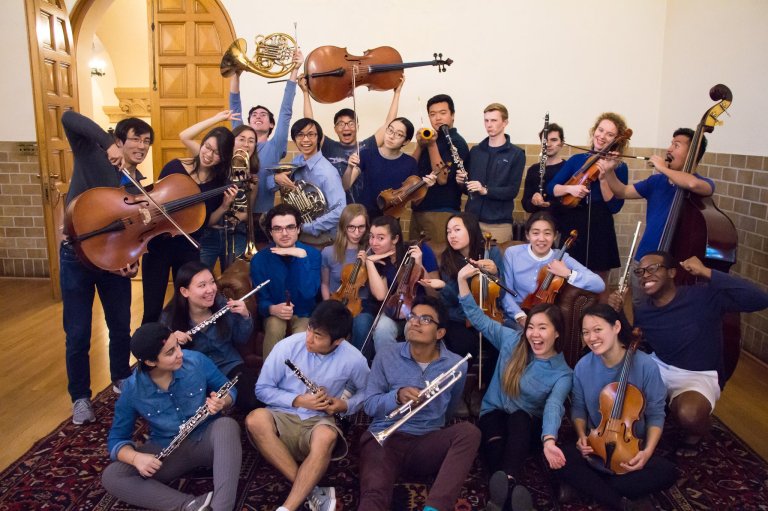Last Friday night, under the soft lights of Toyon’s lounge, Stanford Collaborative Orchestra (SCOr) swept the audience away on a musical adventure. Layers of strings, woodwinds and incredible pianists carried the listeners through a dizzyingly gorgeous set and reminded me of just how many amazing musicians Stanford has. SCOr’s spring concert, “Good Vibrations,” featured a set of five pieces from various composers and eras, and each was performed with passion and skill.
SCOr was created in 2015, with the mission statement of becoming “Stanford’s first student-run, conductorless symphonic ensemble.” SCOr prides itself in being an orchestra “of the students, by the students and for the students.” I had no reservations about this model prior to attending the concert, yet I was still overwhelmed by the amount of talent in the room. The 30 piece group contained violins, violas, cellos and basses, as well as flutes, clarinets, oboes, bassoons, french horns, trumpets, trombones, percussion and pianos. To create such unity of sound from a group with no conductor is a truly impressive feat, and SCOr impressed me time and time again with their skill.
The night opened with Beethoven’s “Overture to Egmont,” the overture to a collection of incidental music for Goethe’s play of the same name. From the opening chords, I was excited to hear what would come next, and SCOr kept me gripped throughout the entire performance. I did not know what to expect from a conductorless orchestra, but hearing the sharp entrances and exits, the stunning crescendos and the articulated silences, I found myself wholly impressed by the ensemble’s skill. In this show, the overture excited me not for a play, but for what was to come next from the group.
Next, a smaller group of musicians came on to perform Poulenc’s “Sextet for Piano and Wind Quintet.” The group is the new Stanford Collaborative Quintet, also known as the Stanford Wind Kwyn-tet. I felt that the conductorless approach really shone in the smaller group. The quintet contained a piano, as well as a traditional wind quintet of flute, oboe, clarinet, bassoon and French horn. I was treated to a group of musicians who clearly knew how to listen to one another, and the blending of the instruments was beautifully and masterfully done.
Next, the strings of SCOr returned to play Dvorak’s “String Serenade.” I was again impressed by the dynamic contrast that the ensemble managed to create without a conductor. Generally, an orchestra watches the conductor’s gestures to receive instructions on things like dynamics and expressive techniques, but in SCOr’s case, there was no one up front telling them what to do. To achieve this, it was clear that the musicians really heard each other, and I never felt that one player was overpowering the group in any way. The democratic approach SCOr takes likely plays into this quite a bit—all the musicians seemed genuinely excited to be playing, and it showed in their performance.
After a brief intermission, the full orchestra returned to perform Shostakovich’s “Piano Concerto No. 2.” The piece has been one of my favorites for years, and my expectations were high. Needless to say, they were met, if not exceeded by SCOr’s performance. The concerto was originally written for Shostakovich’s son upon his graduation from the Moscow Conservatory, and contains technically difficult passages and soaring melodies. They featured three different pianists on each of the three movements, allowing me to be impressed by more than one of the amazing pianists we have at Stanford. The pianists, Lena Han (‘22), Kevin Su (‘21) and Taide Ding (‘17) all demonstrated both technical talent and emotional interpretive talent. From the first movement, I was impressed by Han, as well as SCOr’s ability to support them. In the piece, the piano plays more as part of the ensemble at times, and sometimes it shines on its own. The orchestra understood this and played to feature the piano however it best fit the piece. In the second movement, Su brought out the emotion that makes the piece so powerful, and the orchestra again supported them to the perfect degree. By the third movement, I was impressed a third time by the soloist, Ding, as well as SCOr’s ability to adapt and support each soloist to their strengths. For a piece that is so special to me, I was so glad SCOr was able to do it such justice.
The concert closed with an original composition by Jeffery Chang titled “Rhapsody on a Meme.” In his own words, the piece is described as “not intend[ing] to convey any sort of profound sentiment, nor is it meant to exist as high art. It is a meme.” For any young composer, writing a piece that handles so many parts is an impressive accomplishment, and the talent of both the group and the composer again was showcased.
The most special thing I took away from the show was a reminder—a reminder of how much talent there is at Stanford, and how often we forget to celebrate it. Had I not attended this concert, I never would have seen so many talented performers working in their element, spreading so much joy through their music. I encourage anyone who can to attend a SCOr concert and appreciate the amazing musicians who play together there.
Contact Caroline Baker at cehbaker ‘at’ stanford.edu.
